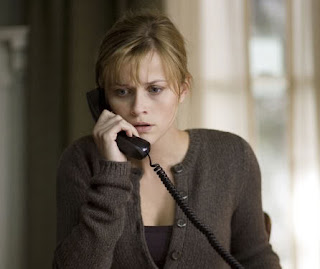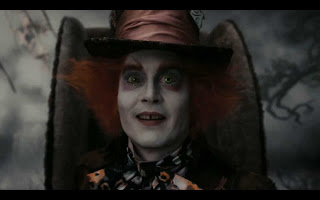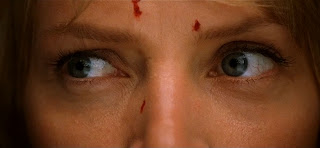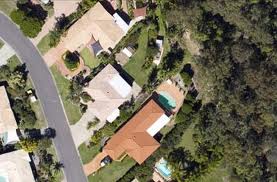I have researched Film Language and the types of shots that I could use in my teaser trailer or the ancilliary products. I have found examples and explanations for each;
Establishing shot -
This is an establishing shot of New York. Establishing shots are used to show the audience where the action is taking place. For my product, I could use an establishing shot to show where my Thriller will be set, OR I could challenge conventions and deliberatley not put in an establishing shot, to unsettle my audience.
Very Wide Shot -
These shots are used to show the subject of a scene in the context of it's surroundings. It is often used after an establishing shot. In this instance, this still shows a man with a car near a large house that is surrounded by waste land. If I used this in my product I could show the characters within the surroundings to inform my audience where they are. But I could also create a sense of confusion by not following the conventions and not showing a very wide shot of my characters.
Wide Shot -
A wide shot is a cross between a long shot and a very wide shot. It shows the subject in the context of it's surroundings, but the subject is closer in a wide shot than in a very wide shot. In my project, this will be useful to emphasize surroundings or a bad situation because my genre of teaser trailer is Thriller.
Mid Shot -
Mid-shots are used to show the subject delievering information. You can also see hand gestures and/or movement. In this example, you can see a Jewish man from the film 'The Pianist' set in world war two. It has been used to show what he is doing, and also to show the Star of David arm band which is a key piece of mise-en-scene for the film. In my teaser trailer, I could use this to show important costumes or props that will be significant.
Medium Close-up -
 Medium close-ups show expression without getting too close. It is half way between a mid-shot and a close up. Here, it shows the worry on Reese Witherspoon's face without just having her head fill the whole shot, which is more effective, in this instance, due to the prop telephone used. This will be a really good style of shot to use in my teaser trailer because I can use it to my advantage - either revealing or concealing something from my audience.
Medium close-ups show expression without getting too close. It is half way between a mid-shot and a close up. Here, it shows the worry on Reese Witherspoon's face without just having her head fill the whole shot, which is more effective, in this instance, due to the prop telephone used. This will be a really good style of shot to use in my teaser trailer because I can use it to my advantage - either revealing or concealing something from my audience.Close-up -
 Usually meaning a close-up of their face, this shot is used for showing detail and therefore could be used to emphasize emotional state. This is a close up of the Mad Hatter from Tim Burton's 'Alice in Wonderland', which shows the detail of his face and also the fact he is happy at this precise moment. This shot will be useful in my teaser trailer because it could be used to show emotions of a victim or criminal which could reveal or conceal things from the audience. This is definately a shot I will be using!
Usually meaning a close-up of their face, this shot is used for showing detail and therefore could be used to emphasize emotional state. This is a close up of the Mad Hatter from Tim Burton's 'Alice in Wonderland', which shows the detail of his face and also the fact he is happy at this precise moment. This shot will be useful in my teaser trailer because it could be used to show emotions of a victim or criminal which could reveal or conceal things from the audience. This is definately a shot I will be using! Extreme close ups can be used to conceal or reveal a person's intentions/emotional state. Likewise it can be used on objects to foreshadow events. This is a classic example of a close up to show a person's feelings, as this lady is looking around anxiously to show she is scared. This will be a vital shot in my teaser trailer given the genre I am filming, as it won't give away too much plot and the audience should be hooked by it's mystery.
Extreme close ups can be used to conceal or reveal a person's intentions/emotional state. Likewise it can be used on objects to foreshadow events. This is a classic example of a close up to show a person's feelings, as this lady is looking around anxiously to show she is scared. This will be a vital shot in my teaser trailer given the genre I am filming, as it won't give away too much plot and the audience should be hooked by it's mystery.Cut in -
A cut in can be used purely as an edit point or to emphasize emotion etc. For example, hand movements can show enthusiasm, agitation, nervousness and more obviously, what the person is holding. For my project, I could use a cut in to show a weapon or how fearful a victim is, but I think there is a danger of revealing too much of the story. I will have to be careful if I use this shot.
Point of View -
Point of View (PoV) shots are simply used to show action from someone's perspective. This is a really nice shot from 'Harry Potter and The Deathly Hallows Part One' showing Harry looking at himself in the mirror. I think this type of shot would be really useful in a thriller movie, but maybe not the teaser trailer, because the meaning would be lost in the trailer unless it was 'Blair Witch' styled.
Longshot -
Long shots typically show the entire object/person and can place it/them in the context of their surroundings. This is a picture of Tom Hanks playing Forrest in 'Forrest Gump'. It's a really nice shot, in terms of the film, because it shows Forrest sat on a bench at a bus stop with his all important box of chocolates. In my project I could use this shot to show either the victim or 'baddy' and reveal a tiny piece of contextual surroundings, rather than using a wide shot which arguably rveals too much for a teaser trailer.
Two shot -
This is a framing technique encompassing two people/subjects. These shots are used to show the emotional reactions between the subjects. This is from the award winning film 'An Education', and it shows that this couple are in love and that they are intrigued by each other and their conversation. I could use a two-shot in my thriller teaser trailer to show the victim with the 'baddy' in the background, as a kind of stalker or to show that he is always watching.
Crane shot -
Often used to show the isolation of a character (grey and white picture), or to demonstrate a particular area (colour picture). These shots are most commonly used at the end of films. I could use a shot similar to the grey and white picture because I could use it to show the isolation of the victim in my thriller, however I don't think I will need this style of shot within my trailer, unless I use this as a kind of establishing shot at the beginning. (I also won't have the eqiupment!)
Aerial shot -
 This shot gives us a view of the ground from (usually) a helicopter. If the aerial shot is of a character, it can be used to make them seem insignificant. It can also be used as an establishing shot. I won't use this style of shot in my teaser trailer because I feel they give away too much plot. I don't want the audience to know everything about my film in the teaser trailer, because otherwise it defeats the object of creating a teaser trailer.
This shot gives us a view of the ground from (usually) a helicopter. If the aerial shot is of a character, it can be used to make them seem insignificant. It can also be used as an establishing shot. I won't use this style of shot in my teaser trailer because I feel they give away too much plot. I don't want the audience to know everything about my film in the teaser trailer, because otherwise it defeats the object of creating a teaser trailer. Low angle shot -
Also known as the 'worm's eye view', this shot gives instant power to the subject or person in the shot. It is a technique sometimes used in confrontational scenes. In this shot, Mrs Lovett, played by Helena Bonham-Carter in 'Sweeney Todd', finds out about the death of Mr Pirelli and realises she isn't scared of Mr Todd. This will be a really good shot to use in my teaser trailer for the 'baddy' which will also be unsettling for the audience knowing that he has the power.
High Angle shot -
This shot can also be used in scenes of confrontation and fight scenes to show which people are more vulnerable. However, it can also be used to enable the viewer to 'survey' the scene. In this shot, Sam Wise Gamgee is being cornered by Shelob and he is a lot smaller (being a hobbit) so as a result, he has very little power in this scene. I could use this style shot to show the victim's vulnerabilty in my teaser trailer.
Eye Level angle -
It's the perspective most familiar to us - we usually see things from our own eye-level. This shot shows Prince Dastin (Jake Gyllenhaal) in 'Prince of Persia' at eye level, which automatically makes the audience empathise with him because he is shown as 'normal'. I will probably avoid this shot in my teaser trailer, because I don't think it fits into the Thriller genre as it doesn't really imply anything bad or unsettling.
Canted angle -
In a canted angle, the camera is tilted on its horizontal plane to produce a slightly unstable picture. This suggests a feeling of excitement or suspense to the viewer, since this is a view of the world that we are not used to seeing. This would be perfect for my Thriller teaser trailer, because suspense is a key ingredient to any thriller. However, I will have to be careful not to over-use this technique because it will lose effectiveness.
Over the Shoulder shot -
Quite simply, this shot shows another subject or person, over the shoulder of another person. This is a perfect example showing Regina George (Rachel McAdams) over the shoulder of Cady Harron (Lindsey Lohan) from 'Mean Girls'. I could use this shot in my trailer to perhaps show the victim over the shoulder of the 'baddy' to show her vulnerabilty.















No comments:
Post a Comment